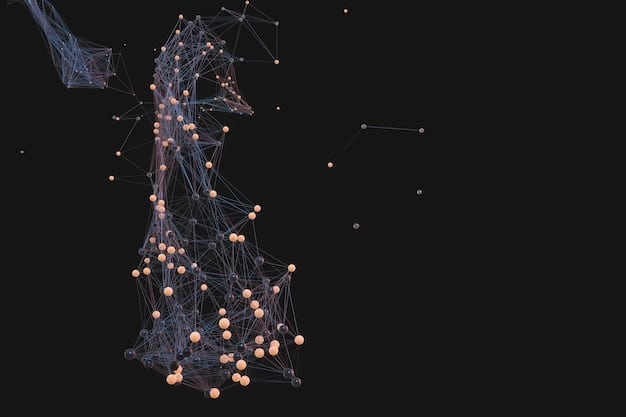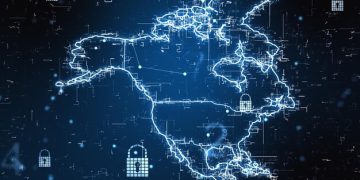Data Privacy in the Age of AI: New US Regulations in 2025

Data Privacy in the Age of AI: Understanding the New US Regulations Taking Effect in January 2025 emphasizes the critical changes in data protection laws, ensuring businesses and individuals are prepared for compliance and understand their rights in an increasingly AI-driven world.
Are you ready for the data privacy landscape to change? The rise of artificial intelligence (AI) brings incredible opportunities, but also significant challenges to how we handle personal information. As we approach 2025, new US regulations are set to take effect, impacting businesses and individuals alike. This article will dive deep into Data Privacy in the Age of AI: Understanding the New US Regulations Taking Effect in January 2025, explaining what you need to know to stay compliant and protect your data.
Navigating Data Privacy in the AI Era
The digital world is evolving at an unprecedented pace, largely driven by advancements in artificial intelligence. This evolution necessitates a re-evaluation of existing data privacy frameworks to address the novel challenges posed by AI technologies. Understanding these challenges and the upcoming regulations is crucial for both businesses and consumers.
AI’s Impact on Data Privacy
AI algorithms rely on vast amounts of data to learn and make predictions. This data often includes personal information, raising concerns about how this information is collected, used, and protected. The increased use of AI in various sectors, from healthcare to finance, amplifies these concerns.
- Data Collection: AI systems often collect data passively and continuously, sometimes without explicit consent.
- Data Usage: AI algorithms can use personal data for purposes beyond the original intent, potentially leading to unforeseen privacy violations.
- Data Security: AI systems are vulnerable to data breaches, which can expose sensitive personal information to unauthorized parties.
- Bias and Discrimination: AI algorithms can perpetuate and amplify existing biases in data, leading to discriminatory outcomes.
The intersection of artificial intelligence and data privacy necessitates a robust legal framework that protects individuals’ rights while fostering innovation. The forthcoming regulations aim to strike this balance.

Key Components of the New US Regulations
The upcoming regulations are designed to address the specific challenges posed by AI to data privacy. Several key components aim to provide a comprehensive framework for protecting personal information in the age of artificial intelligence. These regulations are designed to evolve with the technology.
Enhanced Consent Requirements
One of the central aspects of the new regulations is the emphasis on enhanced consent requirements. Businesses will need to obtain explicit consent from individuals before collecting and using their personal data, especially when AI algorithms are involved. This consent must be informed, specific, and freely given.
This provision ensures that individuals have greater control over their personal information and are aware of how it is being used by AI systems. It also mandates that businesses provide clear and accessible information about their data practices. It is essential that users have control over their data.
Data Minimization Principles
The regulations also incorporate data minimization principles, which require businesses to collect and retain only the data that is strictly necessary for a specific purpose. This principle aims to reduce the amount of personal information that is processed by AI systems, thereby minimizing the risk of privacy violations.
This component is crucial for reducing the attack surface for potential data breaches and ensures that businesses are not hoarding unnecessary personal information. By limiting data collection, organizations can better manage their privacy obligations.
Transparency and Explainability
Transparency is a critical component of the new regulations. Businesses are required to provide clear and accessible information about how their AI systems work, including the types of data they use and the decisions they make. This requirement aims to promote accountability and trust in AI technologies.
Additionally, the regulations require explainability, meaning that businesses must be able to explain how their AI systems arrived at specific decisions, especially when those decisions have a significant impact on individuals. The push for transparency promotes accountability with the collection of data.

Enforcement and Penalties
To ensure compliance with the new regulations, strong enforcement mechanisms are put in place. Organizations that violate the regulations may face significant penalties, including fines and legal actions. It is also imperative that there is a strong legal framework to ensure compliance.
Regulatory Oversight
Federal agencies will have the authority to oversee and investigate potential violations of the data privacy regulations. These agencies will be responsible for enforcing the rules and ensuring that businesses are held accountable for their data practices.
- Audits and Assessments: Regular audits and assessments will be conducted to ensure compliance.
- Whistleblower Protection: Mechanisms to protect whistleblowers who report privacy violations.
- Consumer Redress: Opportunities for consumers to seek redress for privacy violations.
Penalties for Non-Compliance
Non-compliance with the new regulations can result in severe penalties. These penalties may include hefty fines, legal injunctions, and reputational damage. The severity of the penalties will depend on the nature and extent of the violation.
Preparing for the New Regulations
As the effective date of these regulations approaches, it is imperative for businesses to take proactive steps to prepare. This includes understanding the regulations, assessing current data practices, and implementing necessary changes. Preparation is key for compliance.
Understanding the Regulations
The first step in preparing for the new regulations is to gain a comprehensive understanding of their requirements. This includes reviewing the legal text, attending industry seminars, and consulting with legal experts. It is important to understand consent requirements and new legal definitions.
Assessing Current Data Practices
Businesses should conduct a thorough assessment of their current data practices to identify areas where they may not be in compliance with the new regulations. This assessment should cover all aspects of data collection, usage, and security.
Implementing Changes
Based on the assessment, businesses should implement necessary changes to their data practices. This may include updating consent mechanisms, implementing data minimization strategies, and enhancing data security measures. It is important that users know how their data is being used.
Strategic Implications for Businesses
Data Privacy in the Age of AI: Understanding the New US Regulations Taking Effect in January 2025 is not just about compliance; it also presents strategic opportunities for businesses. Companies that prioritize data privacy and ethical AI practices can gain a competitive advantage and build stronger relationships with their customers.
Building Trust and Transparency
Consumers are increasingly concerned about data privacy and are more likely to trust businesses that are transparent about their data practices. By implementing robust data privacy measures, businesses can build trust and enhance their reputation.
This can lead to increased customer loyalty, positive word-of-mouth, and a stronger brand image. Transparency builds trust with your clients.
Gaining a Competitive Advantage
Businesses that prioritize data privacy can also gain a competitive advantage. By demonstrating a commitment to protecting personal information, companies can differentiate themselves from their competitors and attract customers who value privacy.
- Enhanced Customer Loyalty: Improved data privacy practices can enhance customer loyalty.
- Stronger Brand Image: Prioritizing privacy can strengthen your brand image.
- Attracting Talent: Ethical AI practices can attract top talent to your organization.
The Future of Data Privacy
The new US regulations are just the beginning of a broader trend towards greater data privacy and ethical AI practices. As AI technologies continue to evolve, it is likely that data privacy regulations will become even more stringent and comprehensive.
By staying ahead of the curve and embracing data privacy as a core strategic value, businesses can position themselves for long-term success in the age of AI. This is key to staying ahead of the curve and ensuring compliance.
| Key Aspect | Brief Description |
|---|---|
| 🛡️ Enhanced Consent | Explicit consent required for data collection and use, ensuring user awareness and control. |
| 📏 Data Minimization | Collecting only strictly necessary data for specific purposes to reduce privacy risks. |
| 🔬 Transparency | Providing clear information about AI system operations and data usage to promote trust. |
| ⚖️ Enforcement | Federal agencies will oversee and penalize non-compliance with data privacy regulations. |
Frequently Asked Questions
The key objectives are to enhance data privacy through increased transparency, stronger consent requirements, and strict enforcement of data minimization principles in AI-driven systems.
Businesses will need to reassess their data practices to comply with stricter consent and transparency requirements, potentially leading to increased operational costs and the need for more robust security measures to avoid penalties.
Individuals should stay informed about their rights, review privacy policies carefully, and actively manage their consent preferences to control how their personal data is collected and used by AI systems.
Non-compliant organizations could face substantial financial penalties, legal injunctions, and significant reputational damage, depending on the scope and severity of the violation.
Enhanced transparency mandates clear communication about data usage and AI decision-making processes, empowering individuals to make informed choices about their data and holding organizations accountable for their practices.
Conclusion
As January 2025 approaches, understanding Data Privacy in the Age of AI: Understanding the New US Regulations Taking Effect in January 2025 is crucial for individuals and businesses alike. The regulations aim to address challenges posed by AI while balancing innovation. By staying informed and proactively implementing changes, businesses can ensure compliance and build stronger relationships with their customers.





